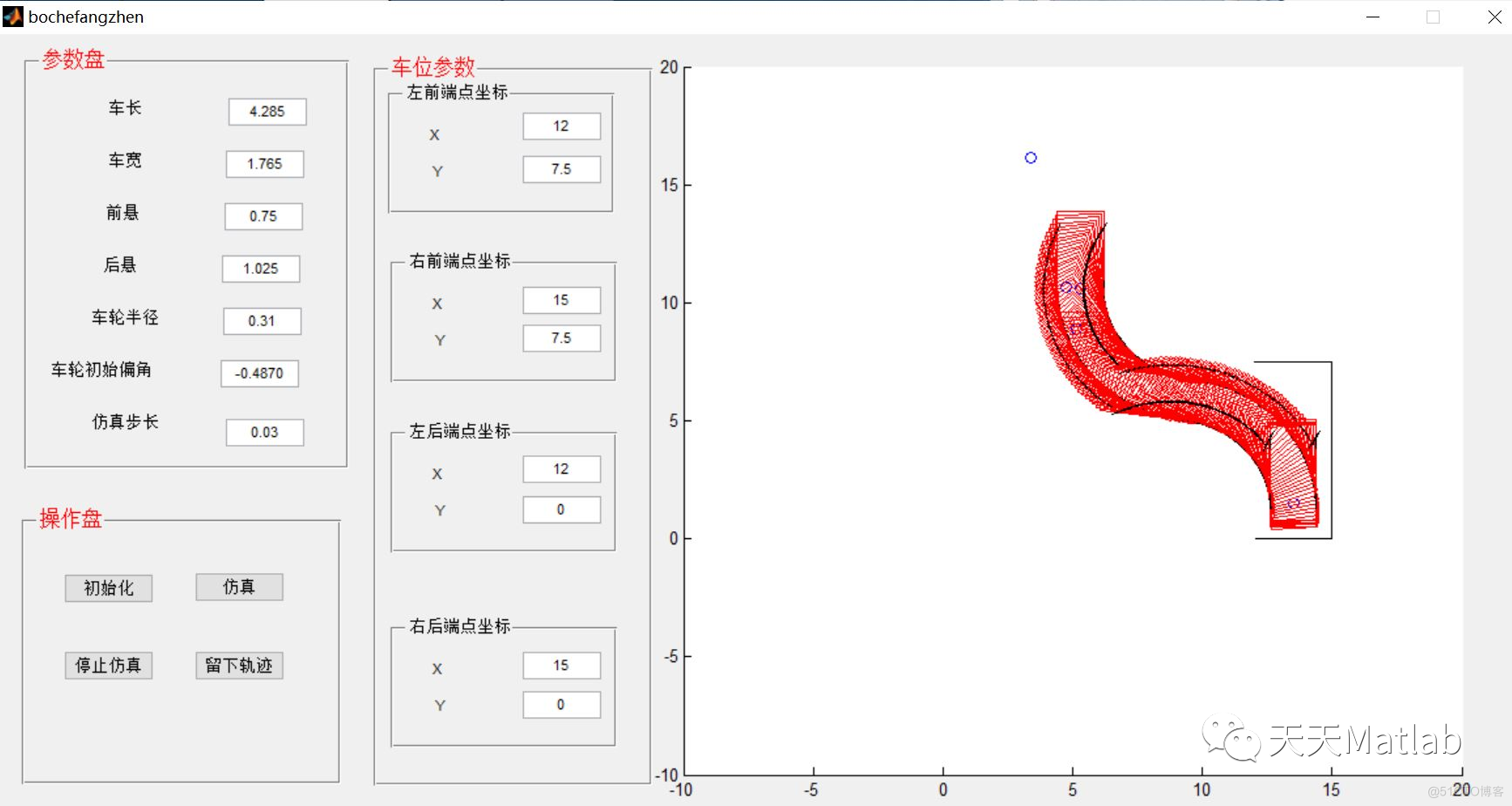1 简介 近年来,智能化的自动泊车技术不断发展.文章针对自动平行泊车轨迹曲率过大,曲率不连续和泊车起始位置,车身姿态要求较为苛刻等问题,提出了最小半径自动平行泊车方法。 2 部
1 简介
近年来,智能化的自动泊车技术不断发展.文章针对自动平行泊车轨迹曲率过大,曲率不连续和泊车起始位置,车身姿态要求较为苛刻等问题,提出了最小半径自动平行泊车方法。
2 部分代码
function varargout = bochefangzhen(varargin)% BOCHEFANGZHEN M-file for bochefangzhen.fig
% BOCHEFANGZHEN, by itself, creates a new BOCHEFANGZHEN or raises the existing
% singleton*.
%
% H = BOCHEFANGZHEN returns the handle to a new BOCHEFANGZHEN or the handle to
% the existing singleton*.
%
% BOCHEFANGZHEN('CALLBACK',hObject,eventData,handles,...) calls the local
% function named CALLBACK in BOCHEFANGZHEN.M with the given input arguments.
%
% BOCHEFANGZHEN('Property','Value',...) creates a new BOCHEFANGZHEN or raises the
% existing singleton*. Starting from the left, property value pairs are
% applied to the GUI before bochefangzhen_OpeningFcn gets called. An
% unrecognized property name or invalid value makes property application
% stop. All inputs are passed to bochefangzhen_OpeningFcn via varargin.
%
% *See GUI Options on GUIDE's Tools menu. Choose "GUI allows only one
% instance to run (singleton)".
%
% See also: GUIDE, GUIDATA, GUIHANDLES
% Edit the above text to modify the response to help bochefangzhen
% Last Modified by GUIDE v2.5 30-Aug-2010 12:37:35
% Begin initialization code - DO NOT EDIT
gui_Singleton = 1;
gui_State = struct('gui_Name', mfilename, ...
'gui_Singleton', gui_Singleton, ...
'gui_OpeningFcn', @bochefangzhen_OpeningFcn, ...
'gui_OutputFcn', @bochefangzhen_OutputFcn, ...
'gui_LayoutFcn', [] , ...
'gui_Callback', []);
if nargin && ischar(varargin{1})
gui_State.gui_Callback = str2func(varargin{1});
end
if nargout
[varargout{1:nargout}] = gui_mainfcn(gui_State, varargin{:});
else
gui_mainfcn(gui_State, varargin{:});
end
% End initialization code - DO NOT EDIT
% --- Executes just before bochefangzhen is made visible.
function bochefangzhen_OpeningFcn(hObject, eventdata, handles, varargin)
% This function has no output args, see OutputFcn.
% hObject handle to figure
% eventdata reserved - to be defined in a future version of MATLAB
% handles structure with handles and user data (see GUIDATA)
% varargin command line arguments to bochefangzhen (see VARARGIN)
% Choose default command line output for bochefangzhen
handles.output = hObject;
% Update handles structure
guidata(hObject, handles);
% UIWAIT makes bochefangzhen wait for user response (see UIRESUME)
% uiwait(handles.figure1);
% --- Outputs from this function are returned to the command line.
function varargout = bochefangzhen_OutputFcn(hObject, eventdata, handles)
% varargout cell array for returning output args (see VARARGOUT);
% hObject handle to figure
% eventdata reserved - to be defined in a future version of MATLAB
% handles structure with handles and user data (see GUIDATA)
% Get default command line output from handles structure
varargout{1} = handles.output;
% --- Executes on button press in pushbutton1.
function pushbutton1_Callback(hObject, eventdata, handles)
global long;% 使这个变量变成全局变量
global width;% 使这个变量变成全局变量
global qianxuan;% 使这个变量变成全局变量
global houxuan;% 使这个变量变成全局变量
global lunjin;% 使这个变量变成全局变量
global fai;% 使这个变量变成全局变量
global x6;% 使这个变量变成全局变量
global y6;% 使这个变量变成全局变量
global x7;% 使这个变量变成全局变量
global y7;% 使这个变量变成全局变量
global x8;% 使这个变量变成全局变量
global y8;% 使这个变量变成全局变量
global x9;% 使这个变量变成全局变量
global y9;% 使这个变量变成全局变量
global ds;% 使这个变量变成全局变量
global r;% 使这个变量变成全局变量
global xd;% 使这个变量变成全局变量
global yd;% 使这个变量变成全局变量
axis([-10,20,-10,20]);
axis manual;
hold on;
%%%%%%%%%%%%%%%%%%%%%%%%%%%%%%%%%%%%%%%%%%%%%%%%%%%%%%%%%%%%%%%%%%%%%%%%
%参数集,这里存放的为车辆与车位已经仿真所需的主要参数
%手动输入参数集
long=str2double(get(handles.edit1,'string'));
width=str2double(get(handles.edit2,'string'));
qianxuan=str2double(get(handles.edit3,'string'));
houxuan=str2double(get(handles.edit4,'string'));
lunjin=str2double(get(handles.edit5,'string'));
fai=str2double(get(handles.edit6,'string'));
x6=str2double(get(handles.edit7,'string'));
y6=str2double(get(handles.edit8,'string'));
x7=str2double(get(handles.edit9,'string'));
y7=str2double(get(handles.edit10,'string'));
x9=str2double(get(handles.edit11,'string'));
y9=str2double(get(handles.edit12,'string'));
x8=str2double(get(handles.edit13,'string'));
y8=str2double(get(handles.edit14,'string'));
ds=str2double(get(handles.edit15,'string'));
% long=6;%long 为车车长
% width=3;%width 为车宽
% qianxuan=1;%qianxuan 为车前悬长度
% houxuan=1;% houxuan 为车后悬长度
% lunjin=0.3;%lunjin为车轮半径
% fai=-(pi)/5;%fai 为前一段轨迹的车前轮偏角
%
%
% x6=11;
% y6=15;
% x7=18;
% y7=15;
% x8=18;
% y8=0;
% x9=11;
% y9=0;
%
% ds=0.3; %仿真步长
%自动生成参数集
r=(long-qianxuan-houxuan)/abs(tan(fai));% 车辆的后轴中心点转弯半径
%theta0=(pi)/2;%theta0为起始点车身偏角
xd=(x8+x9)/2;%终点坐标
yd=(y8+y9)/2+1.5;
h0=plot(xd,yd,'bo');
%%%%%%%%%%%%%%%%%%%%%%%%%%%%%%%%%%%%%%%%%%%%%%%%%%%%%%%%%%%%%%%%%%%%%%%
3 仿真结果

4 参考文献
[1]兰贵龙, 贺艺斌. 基于模糊控制的多圆弧路径自动平行泊车仿真[J]. 汽车实用技术, 2022, 47(3):4.
博主简介:擅长智能优化算法、神经网络预测、信号处理、元胞自动机、图像处理、路径规划、无人机等多种领域的Matlab仿真,相关matlab代码问题可私信交流。
部分理论引用网络文献,若有侵权联系博主删除。

